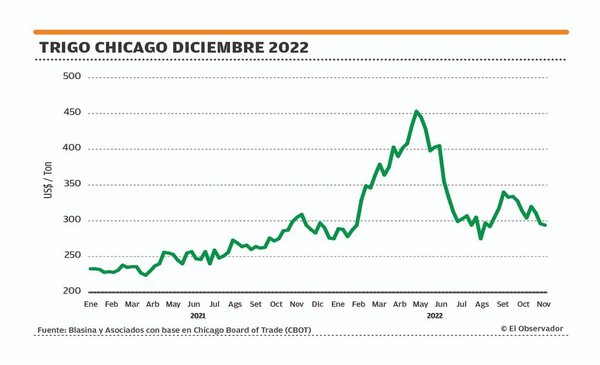The international grain market accentuates a bearish logic. This week it was confirmed that the agreement between Russia and Ukraine to guarantee the export of grains was renewed for four more months. In addition, Ukraine finished its sowing of winter crops on time, with logistical and climatic setbacks but with an area of 4.4 million hectares that is shrinking only because Russia maintains an important area occupied.
The renewal comes with new features because Russian exports of both grains and fertilizers will be made more flexible.
The Kremlin said on Thursday it had been assured by the United Nations that work will be finished to remove barriers to exports of agricultural products and fertilizers from Russia.
The black sea grain dealwhich facilitates Ukrainian agricultural exports from its southern Black Sea ports, be extended for another 120 days without any change to its terms.
Russian officials, including President Vladimir Putin, have said that commitments to ensure the removal of Western barriers, both direct sanctions on a state agricultural bank and the indirect impact of sanctions on Russia’s financial and transport sectors, are a crucial part of the deal. The authorization of Swift codes for the Russian Agricultural Bank continues to be negotiated so that grain and fertilizer exports are fully authorized.
In a conference call with journalists on Thursday, Kremlin spokesman Dmitry Peskov said: “The UN guarantees that the work will be finished to guarantee the export of Russian food and fertilizers”.
He said Russia had already seen progress in easing sanctions, citing a joint statement by the United States, Britain and the European Union not to sanction Russian food and fertilizer exporters, saying work was underway to “eliminate by complete” the remaining obstacles.
On the other hand, the US corn and soybean harvest was completed without setbacks and with yields that were not excellent but were not bad either, and there is a stable supply, not abundant. But the problems continue to get the grain through the Mississippi, which is a bearish pressure on the references of Chicago.
In our opinion, the most important thing is the huge harvest that is coming up in Brazil, where planting is progressing without major setbacks and with availability of water in the soil and soybean production forecasts are consolidated above 150 million tons.
If we add to this the depreciation of the real in Brazil that makes these grains competitive, it can be understood that the market is pointing downwards and is on its way to establishing itself at prices prior to the start of the war.
On the other hand, the rains last weekend here in Uruguay and in Argentina slightly alleviated the critical situation of wheat and allow a better perspective for soybean and corn planting. Rains are expected this Sunday and Monday, reinforcing the prospect of a difficult but not catastrophic year, since the crops are planted with water in the soil and that allows at least a good start for the crops.
In Uruguay the rapeseed harvest advances with generally good yields that exceed 2,000 kg/ha, although there is significant variability, on the other hand, wheat seems to have felt the lack of water more and productivity would not reach last year’s levels of almost 4,000 kg/ha.
The prices offered at the end of the week are around US$510 for soybeans, US$528 for rapeseed, wheat remains stable at US$310 and malting barley at US$290.

















